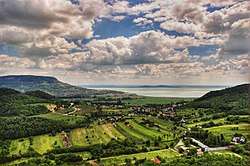Tourism in Hungary
There is a long history of tourism in Hungary,[1] and Hungary was the world's thirteenth most visited tourist destination country in 2002.[2] Tourism increased by nearly 7 percent between 2004 and 2005.[3] European visitors comprise more than 98 per cent of Hungary's tourists. Austria, Germany, and Slovakia make the largest numbers of visitors to the country.[1] Most tourists arrive by car and stay for a short period of time.[4] Hungary's tourist season is from April through October. July and August are the best tourist months.[1] Budapest is the country's most popular tourist destination.[2]
Tourism in Hungary | |
|---|---|
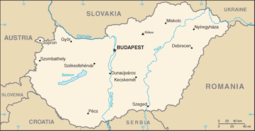 Map of Hungary | |
| Time zone | UTC+1 (Central European Time) |
| Area code(s) | + 36 |
| Website | Official Tourist webpage |
Tourism in Budapest
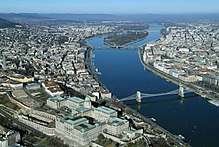
Budapest became one of Central Europe's most popular tourist attractions in the 1990s.[1] Attractions in the city include Buda Castle which houses several museums including the Hungarian National Gallery, the Matthias Church,[5] the Parliament Building and the City Park.[1] The city has many museums, three opera houses, and thermal baths.[5] Buda Castle, the Danube River embankments and the whole of Andrássy Avenue have been recognized as an UNESCO World Heritage Site.[6]
Hungary has an estimated 1,300 thermal springs, a third of which are used as spas across the country. Hungary's thermal waters and spa culture are promoted to tourists. Only France, Japan, Bulgaria, Iceland, and Italy have similar thermal water capacity. Hungary's thermal baths have been used for 2,000 years for cleansing, relaxation and easing aches and pains. The Romans were the first to use Hungary's thermal waters in the first century, when they built baths on the banks of the Danube River.[7] Budapest lies on a geological fault that separates the Buda hills from plains. More than 30,000 cubic metres of warm to scalding (21° to 76 °C) mineral water gushes from 118 thermal springs[8] and supply the city's thermal baths.[6] Budapest has been a popular spa destination since Roman times.[9] Some of the baths in the city date from Turkish times while others are modern.[8] They have steam rooms that utilize the healing properties of the springs.[9] Most of the baths offer medical treatments, massages, and pedicures.[8] The most famous of Budapest's spas were built at the turn of the 19th century.[9]
There are two hundred known caves under Budapest, some of which can be visited by tourists[6] and are a popular tourist attraction.[10] In the Buda hills there are caves that are unique for having been formed by thermal waters rising up from below, rather than by rainwater. The Pálvölgy Stalactite Cave is a large and spectacular labyrinth. Discovered in the 1900s, it is the largest of the cave systems in the Buda hills.[11] The Szemlohegy Cave has no stalactites and has fewer convoluted and claustrophobic passages than the Pálvölgy Cave. The walls in this cave are encrusted with precipitates formed by warm water dissolving mineral salts. The air in the cave is very clean and its lowest level is used as a respiratory sanatorium.[12] The Matyas Cave in the outskirts of the city has a crawling-room-only section called the "sandwich of death."[13]
Regional tourism
Lake Balaton in western Hungary is the largest freshwater lake in Central Europe. It is the second most important tourist destination in Hungary. 2.5 million tourists visited the lake in 1994.[14][15] Hungary's other tourist attractions include spas, excellent facilities for activity holidays, and cultural attractions such as the villages of the Great Hungarian Plain and the art treasures found in Budapest.[4] Hungary has more than 400 camping grounds.[16] There are more than 2,500 km of dedicated bicycle lanes in the country.[17] Fishing is popular in Hungary and almost half of the country's 130,000 hectares of rivers and lakes are used by anglers. The country has excellent opportunities for birdwatching,[18] and horse riding and hunting are also popular.[19]
Tourist regions
According to the Hungarian Central Statistical Office there were 27 695 465 recorded overnight stays in Hungary during 2016 which is +7.0% change compared to 2015.[20]
| Rank | Tourist region | Image | Number of overnight stays (2016) | Share of overnight stays (2016) | Change 2016/1015 |
|---|---|---|---|---|---|
| 1 | Budapest and Central Hungary |  |
10 580 125 | 38.2% | +7.0% |
| 2 | Lake Balaton | 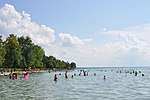 |
5 391 597 | 19.5% | +6.2% |
| 3 | Western Transdanubia | .jpg) |
3 024 201 | 10.9% | +5.1% |
| 4 | Northern Hungary |  |
2 268 372 | 8.2% | +5.6% |
| 5 | Northern Great Plain |  |
2 090 607 | 7.5% | +7.5% |
| 6 | Southern Great Plain | _4.jpg) |
1 709 755 | 6.2% | +6.2% |
| 7 | Central Transdanubia | 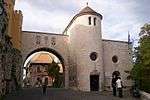 |
1 165 305 | 4.2% | +15.4% |
| 8 | Southern Transdanubia |  |
1 148 375 | 4.1% | +12.2% |
| 9 | Lake Tisza |  |
317 128 | 1.1% | +2.5% |
Statistics
Arrivals by country
Most visitors staying in Hungary on short term basis (not counting visitors staying outside commercial accommodation and day trip visitors) are from the following countries of nationality:[21][22]
| Rank | Country | 2015 | 2016 |
|---|---|---|---|
| 1 | 548,173 | 553,570 | |
| 2 | 351,165 | 376,573 | |
| 3 | 297,103 | 319,904 | |
| 4 | 250,750 | 283,496 | |
| 5 | 268,766 | 275,314 | |
| 6 | 238,455 | 273,165 | |
| 7 | 245,928 | 267,257 | |
| 8 | 251,210 | 258,858 | |
| 9 | 169,982 | 198,061 | |
| 10 | 163,638 | 168,136 |
See also
References
- Hudman, Lloyd E.; Eva H. Essa; Richard H. Jackson (2002). Geography of Travel & Tourism. Thomson Delmar Learning. pp. 284–285. ISBN 0-7668-3256-2. Archived from the original on 2012-11-14. Retrieved 2016-05-15.
- Hall, Derek R. (2004). Tourism and Transition: Governance, Transformation and Development. CABI Publishing. p. 74. ISBN 0-85199-748-1.
- Lyman, Rick (2006-09-03). "Budapest Is Stealing Some of Prague's Spotlight". The New York Times. Archived from the original on 2011-05-20. Retrieved 2008-05-24.
- Boniface, Brian G.; Christopher P. Cooper (2005). Worldwide Destinations: The Geography of Travel and Tourism. Butterworth-Heinemann. pp. 210. ISBN 0-7506-5997-1.
- Bachmann, Helena (2002-03-18). "Beauty and the Feast". Time. Archived from the original on 2008-10-09. Retrieved 2008-05-24.
- "Sights". Budapest Tourism Office. Archived from the original on 2008-12-17. Retrieved 2008-05-24.
- Schweizer, Kristen (2004-03-06). "Hungary: 'Mediterran' thermal spa water park". The Seattle Times. Archived from the original on 2011-05-24. Retrieved 2008-05-24.
- Fallon, Steve (2003). Budapest: Steaming Special Section on Thermal Baths. Lonely Planet. p. 97. ISBN 1-86450-356-4.
- Krezinger, Szonja (2008-05-14). "Your tour guide to Budapest". Metro World News. Archived from the original on 2008-06-06. Retrieved 2008-05-24.
- Swanson, Brandon (2006-06-05). "Digging the way to a new market". The Prague Post. Archived from the original on 2007-10-28. Retrieved 2008-05-24.
- Hebbert, Charles (2002). The Rough Guide to Budapest. Rough Guides. pp. 66–67. ISBN 1-85828-889-4.
- Hebbert, Charles (2002). The Rough Guide to Budapest. Rough Guides. pp. 68. ISBN 1-85828-889-4.
- Bowes, Gemma (2006-02-26). "20 Urban adventures". The Guardian. Archived from the original on 2016-03-07. Retrieved 2008-05-24.
- "Lake Balaton". Encyclopædia Britannica. Archived from the original on 2008-05-22. Retrieved 2008-05-24.
- Hall, Derek (2003). Tourism and Sustainable Community Development. Routledge. p. 39. ISBN 0-415-30915-8.
- Johnstone, Sarah (2005). Europe on a Shoestring. Lonely Planet. p. 585. ISBN 1-74059-779-6.
- Johnstone, Sarah (2005). Europe on a Shoestring. Lonely Planet. p. 586. ISBN 1-74059-779-6.
- Fallon, Steve; Neal Bedford (2003). Hungary. Lonely Planet. p. 55. ISBN 1-74059-152-6.
- Fallon, Steve; Neal Bedford (2003). Hungary. Lonely Planet. p. 56. ISBN 1-74059-152-6.
- "MAGYARORSZÁG TURIZMUSÁNAK ALAKULÁSA 2016-BAN AZ ELŐZETES ADATOK SZERINT : A kereskedelmi szálláshelyek főbb mutatói : A kereskedelmi szálláshelyek vendégforgalmának alakulása" (PDF). Szakmai.itthon.hu. Archived from the original on 11 September 2017. Retrieved 8 October 2017.
- "Tourism in Hungary 2015". Itthon.hu. Archived from the original on 10 September 2017. Retrieved 8 October 2017.
- "TOURISM IN HUNGARY 2016" (PDF). Szakmai.itthon.hu. Archived from the original on 8 October 2017. Retrieved 8 October 2017.
External links
| Wikivoyage has a travel guide for Hungary. |
| Wikimedia Commons has media related to Tourism in Hungary. |
